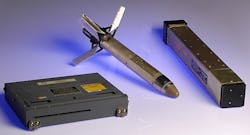Navy asks BAE Systems to build T-1687/ALE-70(V) electronic warfare (EW) towed decoys for F-35
MECHANICSBURG, Pa. – Airborne electronic warfare (EW) experts at BAE Systems will provide the U.S. Navy with fiber optic towed decoys to help defend the F-35 joint strike fighter aircraft from air-to-air missiles and other incoming threats.
Officials of the Naval Supply Systems Command Weapon Systems Support activity in Mechanicsburg, Pa., announced a $70.4 million order Thursday to the BAE Systems Electronic Systems segment in Nashua, N.H., to build the T-1687/ALE-70(V) countermeasures system for the F-35.
Designed and produced by BAE Systems for deployment from the F-35, the ALE-70 towed radio frequency countermeasure consists of the reel and launcher assembly, tow line, T-1687 countermeasure transmitter, and electronic and mechanical subassemblies. It also has canisters, and explosive cartridges to deploy the decoys.
When deployed from the aircraft, the ALE-70’s countermeasure transmitter responds to commands from the countermeasure controller located in the jet and emits waveforms to confuse or decoy adversary radars or radar-guided weapons. The system may be towed or free-flying.
Related: BAE Systems to build hundreds of fiber-optic decoys to protect combat jets from missiles
The Navy is making the order to BAE Systems sole-source because the company is the sole designer, developer, and producer of T-1687/ALE-70(V) countermeasure transmitters, and is the only responsible source with the technical data and requisite knowledge to meet Navy requirements.
The T-1687/ALE-70(V) countermeasures system functions similarly to the AN/ALE-55 fiber optic towed decoys (FOTDs) aboard the Navy's F/A-18E/F Super Hornet jet fighter-bomber fleet, although the ALE-70 is specially designed and fitted to the F-35.
The AN/ALE-55 transmits complex electronic countermeasures signals from a transmitter that trails behind its combat jet to spoof incoming radar-guided anti-aircraft missiles.
Related: Navy chooses Exelis to repair electronic warfare (EW) missile-defense system components
The aircraft-towed decoy with onboard electronics works together with the Super Hornet's electronic warfare system to jam radar seekers in air-to-air missiles. The system also can lure incoming missiles away from their actual targets.
The ALE-55 detects a threat radar in its acquisition mode and uses radar jamming to prevent it from locking to a target. The ALE-55's electronic warfare package analyzes the threat, and the towed decoy emits the jamming signals to confuse the incoming missile's tracking radar. If an incoming missile locks on with radar, the ALE-55 analyzes the signal to determine the best jamming technique to break radar lock.
The ALE-55 system consists of an onboard electronic frequency converter (EFC) and a fiber-optic towed decoy. The EFC converts radio frequency signals sent from the plane’s electronic warfare system into data coded and transmitted via light to the fiber optic towed decoy.
On this T-1687/ALE-70(V) order BAE Systems will do the work in Nashua, N.H., and should be finished by March 2021. For more information contact the Naval Supply Systems Command Weapon Systems Support activity at www.navsup.navy.mil/public/navsup/wss.
Ready to make a purchase? Search the Military & Aerospace Electronics Buyer's Guide for companies, new products, press releases, and videos

